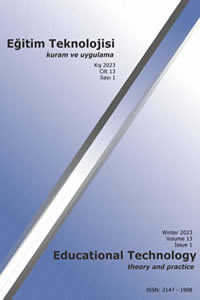Öz
Kaynakça
- Agresti, A. (2002), An Introduction to Categorical Data Analysis, 2. Edition, New York: John Wiley & Sons.
- Alpar, R. (2010). Spor, sağlık ve eğitim bilimlerinden örneklerle uygulamalı istatistik ve geçerlik-güvenirlik. Detay Yayıncılık.
- Beasley, T. M., & Schumacker, R. E. (1995). Multiple regression approach to analyzing contingency tables; Post hoc and planned comparison procedures. Journal of Experimental Education, 64, 79-93. doi.org/10.1080/00220973.1995.9943797
- Cohen, J. (1988). Statistical power analysis for the social sciences. Hillsdale, NJ: Erlbaum. Everitt, B. S. (1977). The Analysis of Contingency Tables. Chapman and Hall: London.
- Field, A. (2018). Discovering statistics using IBM SPSS statistics. Sage Publications.
- Franke, T. M., Ho, T., & Christie, C. A. (2012). The Chi-Square Test: Often Used and More Often Misinterpreted. American Journal of Evaluation, 33(3), 448–458. https://doi.org/10.1177/1098214011426594
- Haberman, S. J. (1973). The analysis of residuals in cross-classified tables. Biometrics, 29, 205-220. doi.org/10.2307/2529686
- Howell, D.C. (2012). Statistical methods for psychology. Cengage Learning.
- Ludbrook, J. (2011). Is there still a place for Pearson's chi-squared test and Fisher's exact test in surgical research?. Australia and New Zealand Journal of Surgery, 81, 923- 926. doi.org/10.1111/j.1445-2197.2011.05906.x
- MacDonald, P. L., & Gardner, R. C. (2000). Type 1 error rate comparisons of post hoc procedures for I J chi-square tables. Educational and Psychological Measurement, 60, 735754. doi.org/10.1177/00131640021970871
- Naioti, E. & Mudrak, E. (2018). Adjusted standardized residuals for interpreting contingency tables. StatNews #95. https://www.cscu.cornell.edu/news/statnews/stnews95.pdf adresinden 2 Eylül 2019 tarihinde erişilmiştir.
- Sharpe, D.E. (2015). Your Chi-Square Test Is Statistically Significant: Now What?. Practical Assessment, Research & Evaluation, 20(8), 1-10.
- Sidak, Z. (1967). Rectangular confidence regions for the means of multivariate normal distributions. Journal of the American Statistical Association, 62, 626-633.
Öz
Araştırmalarda değişkenler arasındaki anlamlı ilişkinin ya da bağıntının keşfedilmesi kadar bu anlamlılığının kaynağının belirlenmesi ve rapor edilmesi de önemlidir. İki yönlü olumsallık çizelgeleri (contingency table) üzerinde gerçekleştirilen ki-kare bağımsızlık testinin anlamlılık ile sonuçlanması durumunda post-hoc testlerinin işe koşulması gerekmektedir. Bu kapsamda çeşitli post-hoc testleri bulunmaktadır. Bu araştırmada gözenek artık (cellwise residual) testlerine odaklanılmıştır. Bu testler anlamlılık üzerinde çizelgedeki gözenek katkılarının değerlendirilmesini sağlamaktadır. Gözenek artık testleri standartlaştırılmış ve düzeltilmiş artık olmak üzere iki yaklaşımı içermektedir. Bu araştırma kapsamında olumsallık çizelgeleri, ki-kare ve artık analizlerine değinilmiş, post hoc yaklaşımlarından düzeltilmiş artık yaklaşımı tanıtılmıştır.
Anahtar Kelimeler
Ki-kare analizi iki yönlü olumsallık çizelgeleri post-hoc yaklaşımları gözenek artık analizi düzeltilmiş artıklar
Kaynakça
- Agresti, A. (2002), An Introduction to Categorical Data Analysis, 2. Edition, New York: John Wiley & Sons.
- Alpar, R. (2010). Spor, sağlık ve eğitim bilimlerinden örneklerle uygulamalı istatistik ve geçerlik-güvenirlik. Detay Yayıncılık.
- Beasley, T. M., & Schumacker, R. E. (1995). Multiple regression approach to analyzing contingency tables; Post hoc and planned comparison procedures. Journal of Experimental Education, 64, 79-93. doi.org/10.1080/00220973.1995.9943797
- Cohen, J. (1988). Statistical power analysis for the social sciences. Hillsdale, NJ: Erlbaum. Everitt, B. S. (1977). The Analysis of Contingency Tables. Chapman and Hall: London.
- Field, A. (2018). Discovering statistics using IBM SPSS statistics. Sage Publications.
- Franke, T. M., Ho, T., & Christie, C. A. (2012). The Chi-Square Test: Often Used and More Often Misinterpreted. American Journal of Evaluation, 33(3), 448–458. https://doi.org/10.1177/1098214011426594
- Haberman, S. J. (1973). The analysis of residuals in cross-classified tables. Biometrics, 29, 205-220. doi.org/10.2307/2529686
- Howell, D.C. (2012). Statistical methods for psychology. Cengage Learning.
- Ludbrook, J. (2011). Is there still a place for Pearson's chi-squared test and Fisher's exact test in surgical research?. Australia and New Zealand Journal of Surgery, 81, 923- 926. doi.org/10.1111/j.1445-2197.2011.05906.x
- MacDonald, P. L., & Gardner, R. C. (2000). Type 1 error rate comparisons of post hoc procedures for I J chi-square tables. Educational and Psychological Measurement, 60, 735754. doi.org/10.1177/00131640021970871
- Naioti, E. & Mudrak, E. (2018). Adjusted standardized residuals for interpreting contingency tables. StatNews #95. https://www.cscu.cornell.edu/news/statnews/stnews95.pdf adresinden 2 Eylül 2019 tarihinde erişilmiştir.
- Sharpe, D.E. (2015). Your Chi-Square Test Is Statistically Significant: Now What?. Practical Assessment, Research & Evaluation, 20(8), 1-10.
- Sidak, Z. (1967). Rectangular confidence regions for the means of multivariate normal distributions. Journal of the American Statistical Association, 62, 626-633.
Ayrıntılar
| Birincil Dil | Türkçe |
|---|---|
| Konular | Alan Eğitimleri |
| Bölüm | Bilgi Köşesi |
| Yazarlar | |
| Erken Görünüm Tarihi | 25 Ocak 2023 |
| Yayımlanma Tarihi | 25 Ocak 2023 |
| Yayımlandığı Sayı | Yıl 2023 Cilt: 13 Sayı: 1 |


